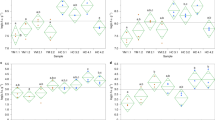Abstract
Samples of a gypsy moth nucleopolyhedrosis virus product, Gypchek®, were taken each day during a 100-day production run and monitored for the presence of pathogenic bacteria and fungi. The standard plate count/g of product was 5.97±1.51×108 over the 100-day period, while the sporulating bacteria count was 3.81±1.21×106/g. We did not detect obligate anaerobic or fecal coliform bacteria in any of the samples.Bacillus cereus, Staphylococcus epidermidis, B. licheniformis, Streptococcus faecalis, Serratia liquefaciens, andAspergillus niger were the most frequently isolated microorganisms. We did not detect primary pathogenic bacteria or fungi, but the presence of opportunistic pathogens indicated that assiduous monitoring of the virus production facility and rigorous quality control of production batches are necessary.
Résumé
Des échantillons d'une préparation à base du virus de la nucléopolyhédrose deLymantria dispar (L.), le Gypchek®, furent prélevés tous les jours durant un cycle de production de 100 jours, et ont été examinés afin d'y détecter des bactéries et champignons pathogénes. Le nombre moyen de colonies bactériennes par gramme du produit était de 5.97±1.51×108 durant la période de 100 jours, tandis que le nombre de bactéries sporulées était de 3.81±1.21×106/g. Nous n'avons trouvé ni bactéries anaérobies ni bactéries coliformes fécales dans aucun des échantillons.Bacillus cereus, Staphylococcus epidermis, B. licheniformis, Streptococcus faecalis, Serratia liquefaciens etAspergillus niger furent les micro-organismes le plus souvent isolés. Nous n'avons pas trouvé de bactéries ou de champignons pathogénes primaires, mais la présence de pathogènes opportunistes indiquait qu'une surveillance assidue de l'équipement de production du virus et un contrôle rigoureux de la qualité des lots de production sont nécessaires.
Similar content being viewed by others
References
American Public Health Association — 1976. Standard methods for the examination of water and wastewater, 14th ed. —Am. Public Health Association, Washington, DC.
Baird-Parker, A.C. — 1963. A classification of micrococci and staphylococci based on physiological and biochemical tests. —J. Gen. Microbiol., 30, 409–427.
Blair, J.E., Lennette, E.H. &Truant, J.P. (eds.) — 1970. Manual of Clinical Microbiology. —Am. Soc. Microbiol., Bethesda, Md.
Buchanan, R.E. &Gibbons, N.E. (ed.). — 1974. Bergey's Manual of Determinative Bacteriology, 8th ed. —Williams & Wilkins Co. Baltimore.
Doane, C.C. &Redys, J.J. — 1970. Characteristics of motile strains ofStreptococcus faecalis pathogenic to larvae of the gypsy moth. —J. Invertebr. Pathol., 15, 420–430.
Edwards, P.R. &Ewing, W.H. — 1972. Identification ofEnterobacteriaceae, 3rd ed. —Burgess Publishing Co., Minneapolis.
Gibbs, B.M. &Shapton, D.A. (eds.) — 1966. Identification Methods for Microbiologists, Part B. —Academic Press, New York.
Gibbs, B.M. &Skinner, F.A. (eds.) — 1966. Identification Methods for Microbiologists, Part A. —Academic Press, New York.
Gordon, R.E., Haynes, W.C. & Hor-Nay Pang, C. — 1973. The genusBacillus. —U.S. Dep. Agric. Agric. Handbook No. 427, Washington, D.C.
Graber, C.D., Rabin, E.R., Mason, A.D. Jr., &Vogel, E.H. Jr., — 1962. Increasing incidence of nosocomialHerellea vaginicola infections in burned patients. —Surg. Genecol. Obstet., 114, 109–112.
Howell, A., Stephan, R.M. &Paul, F. — 1962. Prevalence ofActinomyces israelii, A. naeslundii, Bacteronema matruchetii andCandida albicans in selected areas of the oral cavity. —J. Dent. Res., 41, 1050–1059.
Lamanna, C. &Jones, L. — 1963. Lethality for mice of vegetative spore forms ofBacillus cereus andBacillus cereus-like insect pathogens injected intraperitoneally and subcutaneously. —J. Bacteriol., 85, 532–535.
Larone, D.H. — 1976. Medically Important Fungi, a Guide to Identification. —Harper & Row Publishers, Hagerstown.
Lewis, F.B., McManus, M.L. & Schneeberger, N.F. — 1979. Guidelines for the use of Gypchek to control the gypsy moth. —U.S. Dep. Agric. For. Serv. Res. Pap. Ne-441.
Mossel, D.A.A., Koopman, M.J. &Jongerius, E. — 1967. Enumeration ofBacillus cereus in foods. —Appl. Microbiol., 15, 650–653.
Muraschi, T.F., Friend, M. &Bolles, D. — 1965.Erwinia-like microorganisms isolated from animal and human hosts. —Appl. Microbiol., 13, 128–131.
Podgwaite, J.D. — 1980. Development and utilization of a nucleopolyhedrosis virus (Baculovirus) for control of the gypsy moth. —Mem. 8th, Reunion Nac. Control Biol., Mexico.
Podgwaite, J.D. & Bruen, R.B. — 1978. Procedures for the microbiological examination of production batch preparations of the nuclear polyhedrosis virus (Baculovirus) of the gypsy moth,Lymantria dispar (L.) —U.S. Dep. Agric. For. Serv. Gen. Techn. Rep. Ne-38.
Podgwaite, J.D. &Campbell, R.W. — 1972. The disease complex of the gypsy moth. II. Aerobic bacterial pathogens. —J. Invertebr. Pathol., 20, 302–308.
Redfearn, M.S., Palleroni, N.J. &Stainer, R.Y. — 1966. A comparative study ofPseudomonas pseudomallei andBacillus mallei. —J. Gen. Microbiol., 43, 293–313.
Shapiro, M., Bell, R.A. & Owens, C.D. — 1981.In vivo mass production of gypsy moth nucleopolyhedrosis virus. In: The Gypsy Moth: Research Toward Integrated Pest Management. (C.C. Doane & M.L. McManus, ed.) —U.S. Dep. Agric. Tech. Bull. 1584, 633–655.
Shapiro, M., Owens, C.D., Bell, R.A. &Wood, M.A. — 1980. Simplified efficient system forin vivo mass production of gypsy moth nucleopolyhedrosis virus. —J. Econ. Entomol., 74, 341–343.
Skerman, V.D.B. — 1967. A Guide to the Identification of the Genera of Bacteria, 2nd ed. —Williams & Wilkins Co., Baltimore.
Sutter, V.L., Vargo, V.L. &Finegold, S.M. — 1975. Wadsworth Anaerobic Bacteriology Manual. —Univ. California, Los Angeles.
United States Environmental Protection Agency. — 1975. Guidance for safety testing baculoviruses. In: Baculoviruses for Insect Pest Control: Safety Considerations (M. Summers, R. Engler, L. Falcon &P. Vail, ed.) —Am. Soc. Microbiol., Washington, D.C. 170–184.
Author information
Authors and Affiliations
Rights and permissions
About this article
Cite this article
Podgwaite, J.D., Bruen, R.B. & Shapiro, M. Microorganisms associated with production lots of the nucleopolyhedrosis virus of the gypsy moth,Lymantria dispar [Lep.: Lymantriidae] . Entomophaga 28, 9–15 (1983). https://doi.org/10.1007/BF02372092
Issue Date:
DOI: https://doi.org/10.1007/BF02372092




